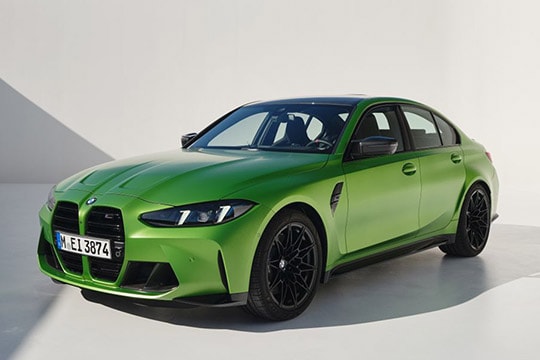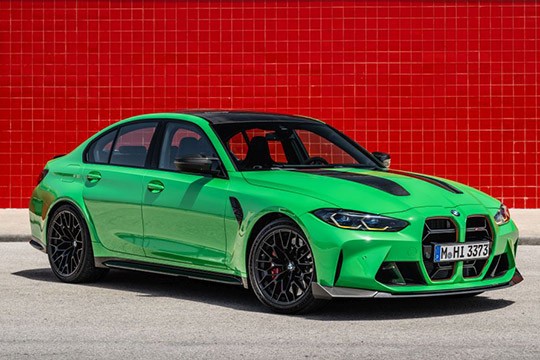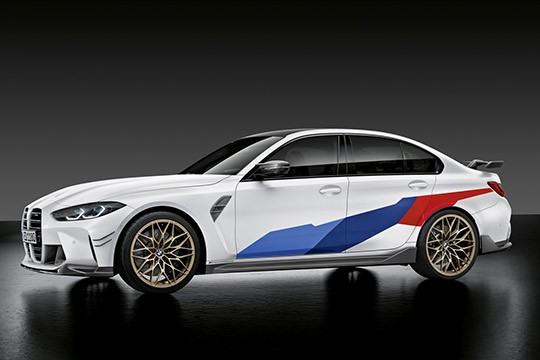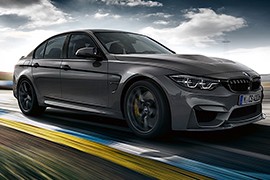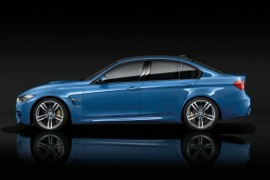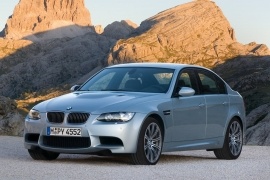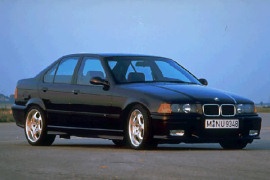BMW M3 Sedan Models/Series Timeline, Specifications & Photos
First production year: 1994
Engines: Gasoline
BMW refreshed the M3 lineup for the 2025 model year in the summer of 2024, with production scheduled to start in July of the same year for both sides of the Atlantic.
The M3 badge was introduced in 1986 on the famous E30 M3, the most successful touring car in racing history. That model was offered only as a two-door affair, either as a coupe or as a convertible. In the following generation, the E46, the automaker installed a straight-six powerplant under the car’s hood and sold it in three shapes: Coupe, Convertible, and sedan. Almost all the other M3s that followed were fitted with six-cylinder engines, besides the mighty M3 GTR, which was powered by a V8. Later on, the automaker went back to the inline-six architecture, albeit with turbocharging technology. Then, in 2013, BMW split the 3 Series lineup into two: the 4 Series for the Coupe, the convertible, and the Gran Coupe versions, and the 3 Series for Sedan and Touring. As a result, the M3 was available only as a four-door or station wagon vehicle. In 2020, BMW introduced the M3 as the M-powered version of the seventh generation of the 3 Series, and by 2024, it was already time for a change. The refreshed sedan, or the LCI (Life Cycle Impulse) model, was introduced in two flavors: the M3 and the M3 Competition.
Up front, the most striking difference was noticed in the new LED headlights, which were available with adaptive and Matrix-LED technology. They flanked the vertical kidney grille, which many hoped would be deleted and reversed to a horizontal styling, like on the rest of the 3 Series range. Above them, the automaker installed a sculptured hood featuring two longitudinal power domes. The angular-shaped air intakes on the lower side of the bumper were a continuation of the upper ones, making it look like nostrils. These were flanked by a pair of side scoops that helped to cool the brakes and created an air curtain around the bodywork to lower drag resistance. At the bottom, the automaker installed a lip spoiler.
From its profile, the aggressive-looking M3 Sedan sported a set of vents that released the air trapped inside the wheel wells. Furthermore, BMW added a set of black side sills that extended towards the back and connected with the flared wheel arches from the rear quarter panels. The automaker also installed new door mirrors sporting an M-specific design with aerodynamic struts. Finally, at the back, the 2025 M3 featured a lip spoiler on the deck, while the LED taillights were split between the quarter panels and the trunk lid. Lower, under the bumper, the German car manufacturer installed a large diffuser that integrated the four exhausts, grouped by two, on each side.
Inside, there were significant technological upgrades. First and foremost, there was a new set of high-bolstered front seats with slim carbon fiber options. On the dashboard, BMW installed a curved panel that covered two screens: one in front of the driver for the main dials and the other for the new 8.5 BMW Operating System. Between the front occupants, the automaker placed a generously sized center console that housed the selector for the automatic transmission or a six-speed manual. Furthermore, the automaker placed there some buttons for the adaptive dampers. In the back, there was enough room for two occupants, separated by a tall transmission tunnel.
Under the hood, BMW used the same straight-six powerplant as many of its predecessors. Thanks to the turbocharging technology, it developed 480 P0S (473 hp) for the six-speed manual with a rear-wheel drive system, while the Competition package added all-wheel drive and an eight-speed automatic transmission, plus some extra oomph.
BMW introduced an extreme version of its four-door sedan M3 in 2023, thus continuing a long tradition of lighter, higher-performance variants for the famous German model.
The history of lightweight versions of BMW's models goes far back in time. From the famous 1972 CSL from the '70s to the E46 M3 CSL or the E92 CRT, they were all focused on one thing only: performance attained thanks to a lighter construction than their regular siblings. But the 2024 M3 CS went further than that by adding much more power to the famous S58 TwinPower Turbo inline-six engine.
For this limited edition version, the German automaker introduced a special color named "Green Goblin, " making the car stand out from the crowd. In addition, the black accents on the hood, front bumper, side sills, and roof were hints of carbon-fiber elements used to create this spectacular four-door vehicle. Finally, at the back, the trunk lid was adorned with a carbon fiber lip spoiler.
Inside, the automaker added more carbon-fiber trims on the center console, dashboard, and steering wheel. In addition, BMW ditched the formerly used seats in the regular M3 and installed a pair of carbon-fiber high-back sports seats upholstered with a combination of fabric and leather. Still, the dual-screen setup was kept so the driver could focus on the main information needed while driving or thrashing the car around the corner on a track but still use the infotainment unit for daily use.
Under the hood, the automaker added 40 more ponies to the already potent M3 engine. While the all-wheel-drive setup was standard, the speed-limiter removal was not. That allowed customers to reach up to 302 kph (188 mph).
The BMW M3 was one of the most iconic models in the German's brand lineup. It was the car that M-madness in the mid-'80s and it continued ever since.
After BMW decided to split its 3-series in two, with the 4-Series for the coupe versions and the 3-Series for the Sedan and station-wagon versions, the rumors about the retirement of an M3 version started to spread. But the M3 didn't die; it just got better.
The seventh generation of the BWM 3 Series was introduced in 2018, but the M3 fans had to wait for another two years to get the top-spec version. The 2020 M3 featured a redesigned front bumper with more aggressive styling. A muscular stance and the flared arches ensured an important image for the sportiest 3-Series. The specific 18” light-alloy wheels were fitted as standard. In the back, the car was fitted with four exhausts. An optional performance package gathered all four pipes in the middle.
Inside, the car was fitted with sport-bucket seats as standard. The instrument cluster featured a TFT color display and, on the center stack, the infotainment system was installed. It featured connectivity via Apple CarPlay and it could support Android phones. If the car was fitted with the automatic gearbox, it was fitted with a pair of paddle-shifters as well.
Under the hood, the M3 surprised its customers with the introduction of the all-wheel-drive system. It was the first M3 in history to send its power to all four wheels. The standard gearbox was a six-speed manual. For that, the power went exclusively to the rear wheels. The xDrive version was available only in conjunction with the 8-speed automatic.
Almost three decades after introducing the E30 M3 Evolution, BMW launched a special version for the F80 M3: the M3 CS.
BMW had a long history of making light, agile cars derived from the M3. It all started in 1988 with the M3 Evolution and continued with the M3-CSL, CRT, or the GTR. In 2017, the German carmaker introduced a new special version of the M3: the CS. It was lighter, with better weight distribution and more power than the regular version. On top of that, it moved the speed limiter from 155 mph (250 kph) to 174 mph (280 kph).
Both the hood and the roof were made out of carbon-fiber-reinforced plastic (CFRP), which shaved 10 kg (22 lbs) from the vehicle's weight. On the trunk's rear edge, BMW added a different carbon-fiber lip-spoiler than on the regular M3. The apron featured a three-section air intake. Its big, 19" light-alloy wheels at the front were complemented by a set of 22" rims at the back. Under the rear bumper, the carmaker installed a diffuser and four exhaust pipes.
Inside, BMW didn't forget that its customers had to pay a six-figure price and created a sporty yet luxurious interior. The carmaker installed a two-tone leather upholstery adorned with Alcantara on the center console and door cards. Another significant standard feature was the infotainment unit and the Harman Kardon sound system Professional.
With a lowered, stiffened suspension and a 460 hp under the hood, the M3 CS was clearly faster than a regular M3. The engine sent its power to the rear wheels via a seven-speed (dual-clutch) automatic transmission and was quicker by 0.4 seconds than a regular M3.
After four generations with M3 in various forms, the fifth-generation of the performance model from BMW was available as a four-door sedan only.
The German car-maker decided to name the coupe versions with even numbers. So, the 3-Series coupe became 4-Series. But that didn't mean to throw away the M3 badges. Those were applied to the four-door BMW 3-Series.
In 2014, BMW announced the sportiest version of the 3-Series, the M3. On the outside, it looked different than the rest of the stable, featuring a new front bumper with a bigger spoiler and wider side-pods as air-intakes. On the front fenders, a set of air-vents enhanced the look of the car, and minimized turbulences in the front wheel arches. Unlike its predecessor, which ad a bulge on the hood due to its massive V8 engine, the M3 had a smaller one more for design purposes and for pedestrian protection. A specific set of 18” light-alloy wheels was installed on the car. In the back, there were four exhausts under the diffuser, which was specifically designed for the M3.
Inside, the M3 showed its family roots in the motorsport arena. High-bolstered seats, special steering wheel, special instrument cluster, and the three-color of the M badge spread around the cabin, on the seats, on the gear-stick, and on the dials.
The 2014 M3, also known as the F80, was the first turbocharged BMW M3. It featured an inline-six unit under the hood. Its 3.0-liter displacement was smaller than the former 4.0-liter V8 of the E92 M3. But it offered more power and more torque than the model it replaced. It was mated as standard to a 6-speed manual and there was an option for a 7-Speed dual-clutch automatic gearbox.
The fourth generation of the M3 and the third generation of the four-door M3 was introduced in 2007 and it was the benchmark in the sport-sedan market. It was the car to beat.
The M3 history started in the '80s with a car built for the street to receive the FIA type approval for the track. The successful E30 M3 was produced only as a two-door vehicle and its successor, the E36 M3, received a four-door version. After that, all of the other M3s were available like that as well as coupe or convertible.
The M3 sedan was easy to differentiate from a standard sedan. In the front, there was a new bumper with a larger grille in the center and two air-dams on the sides. The hood featured a bulge, needed to make room for the bigger engine. From the side, new door mirrors were installed and in the back, four exhaust placed closer to the center were revealed under the bumper.
Inside, the car featured the three colors from the Motorsport GmBH: blue, dark blue, and red, stitched to the upholstery, on the steering wheel and the instrument cluster. The M3 logo was shown as well. The bucket-seats for the front passengers offered a high level of grip in the cornering for its occupants.
But the magic of the M3 was underneath its skin. A 4.0-liter V8 engine in the front sent its power via a 6-speed manual or a 7-speed automatic gearbox (dual-clutch). The car was quicker to 100 kph (62 mph) by 0.2 seconds when equipped with the automatic gearbox. The perfect balance and weight distribution granted a great level of cornering speed.
BMW introduced the second generation of the M3 in 1992 as a coupe, and two years later, it unveiled the four-door version for it.
While the E30 M3 was available only as a coupe, the second generation was available with a four-door sedan and a convertible bodywork. Thus, those who needed a four-door vehicle that was fun to drive and sporty had the option to get one from the German automaker.
Unlike its predecessor, the second generation of the M3 was more subtle. It took someone with a keen eye for detail to distinguish an M-version from a regular one. But there were a few details that revealed the differences. For starters, the front bumper was different. Unlike its regular sibling, the M3 sedan featured an apron that sported a rectangular air intake in the middle, flanked on the sides by two small scoops and squared fog lamps. On the profile, the door mirrors were aerodynamically profiled and mounted on the bodywork with two thinner supports instead of a single, wider one. Moreover, the rocker panels were sculptured so they could divert the air from the sides and prevent it from entering under the car. Finally, at the back, the M3 sedan received a diffuser under the bumper and a wing on the trunk.
Inside, the automaker installed a three-spoke steering wheel with a small M-badge on the lower one. All versions got high-bolstered bucket seats at the front with multiple adjustments. As an option, BMW offered leather upholstery. Also standard was a high-fi sound system and an onboard computer. Worth noticing that the red line on the tachometer started at 7,500 rpm.
Under the hood, the car was introduced with a 3.0-liter inline-six engine that developed 286 PS for the European market but just 240 for the U.S. customers. In 1995, the German automaker upgraded the powerplant to a 3.2-liter displacement that led to 321 PS for European customers but the same 240 ponies for the U.S. market.
